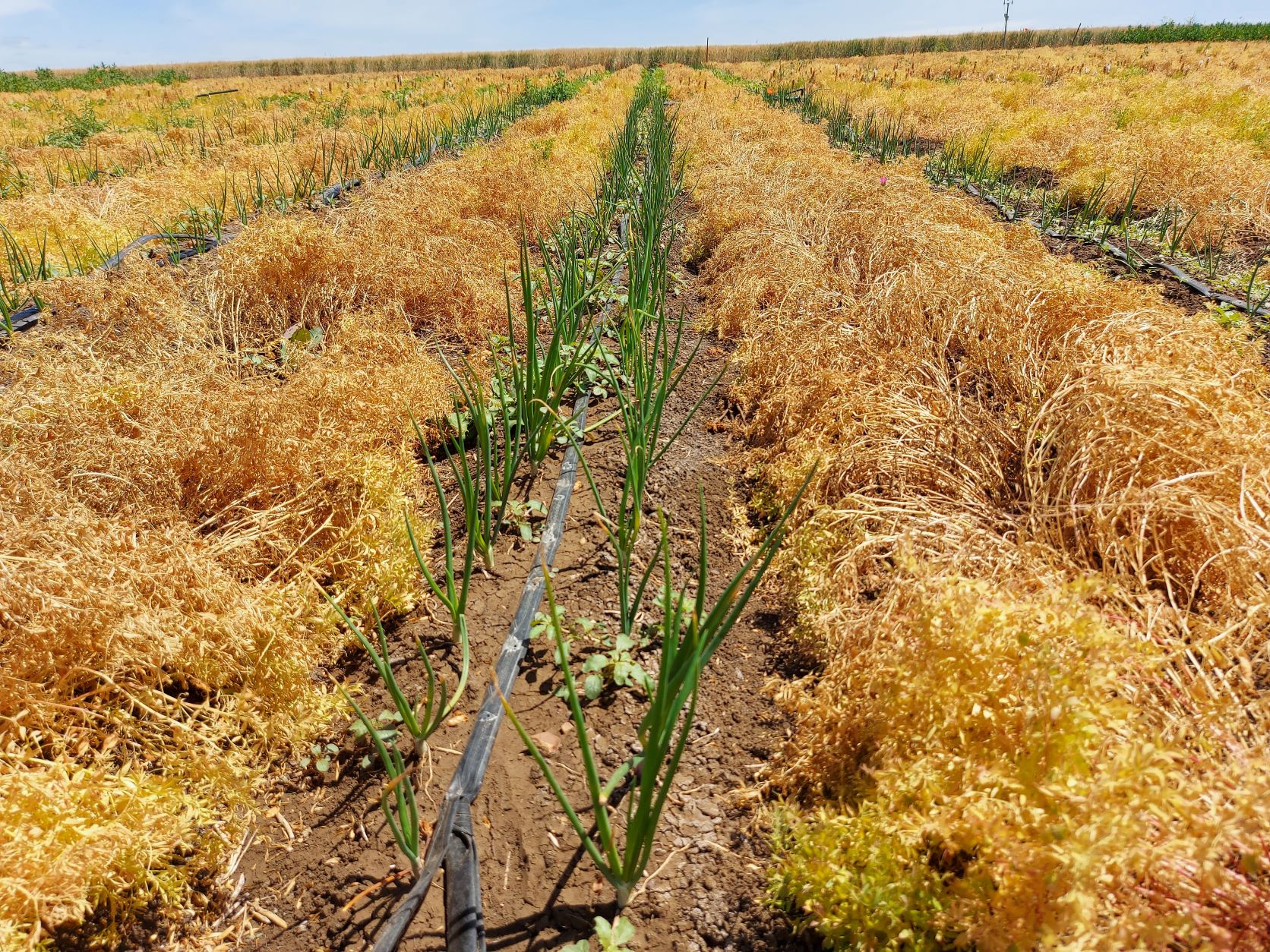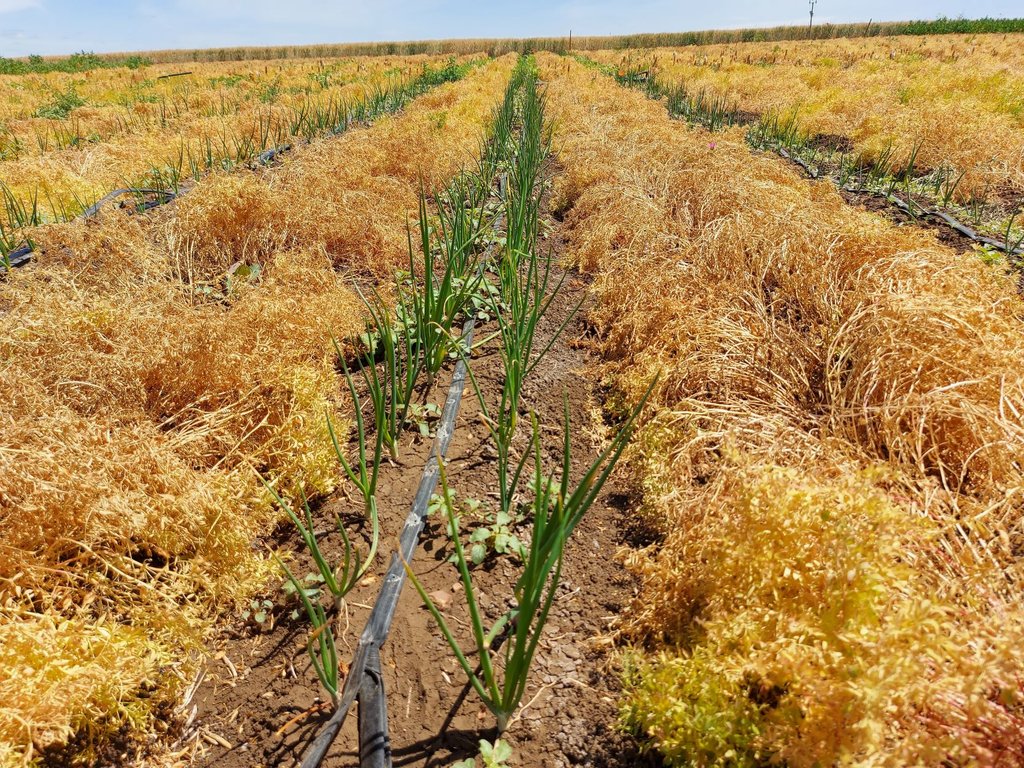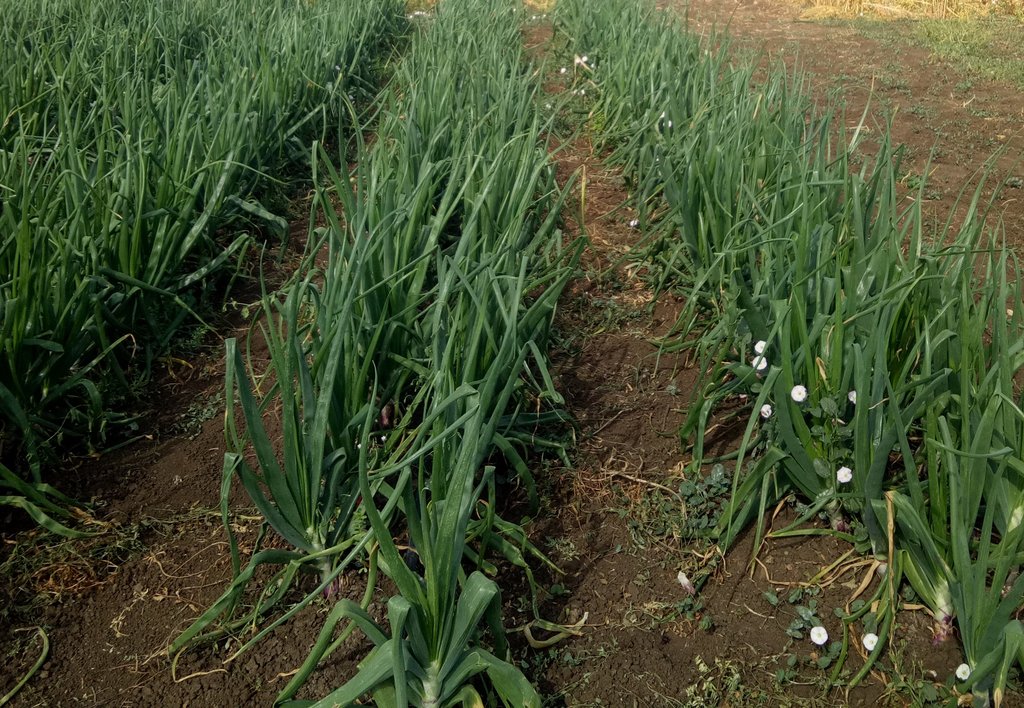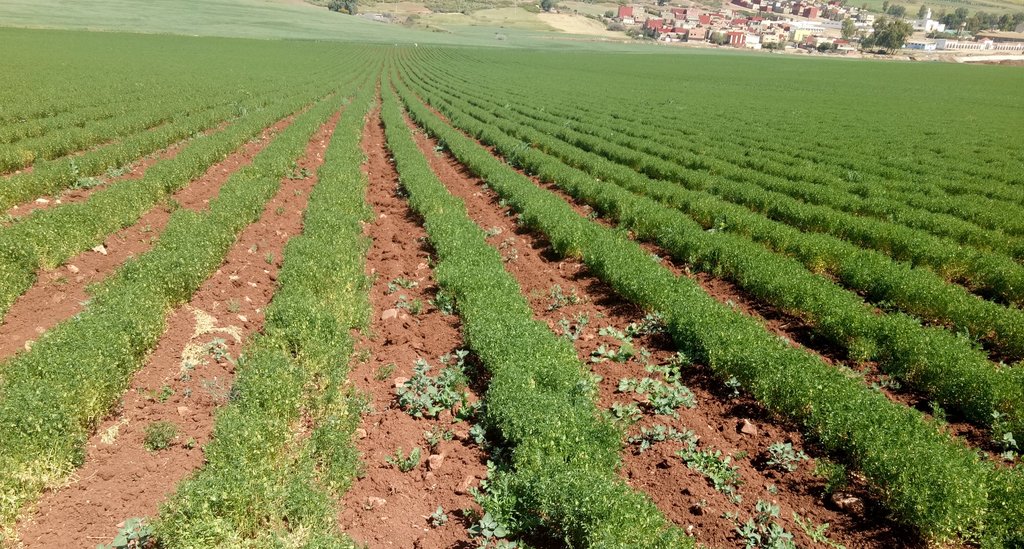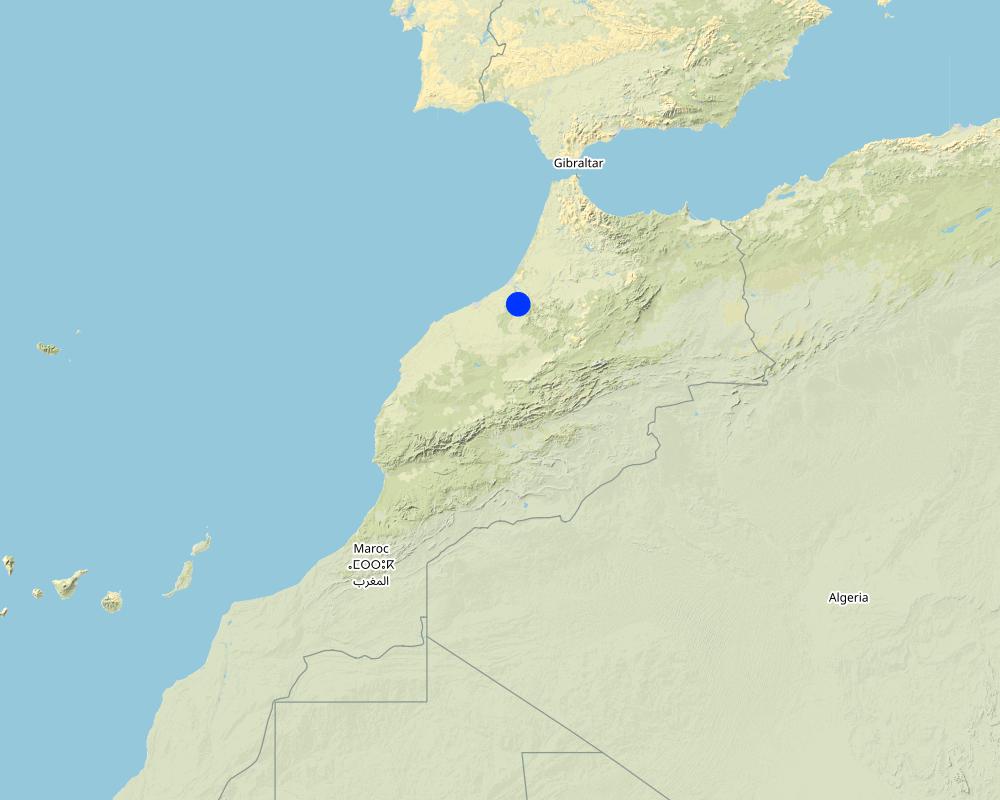Diversified Cropping System: Relay Intercropping of Lentils with Onions [摩洛哥]
- 创建:
- 更新:
- 编制者: Joren Verbist
- 编辑者: –
- 审查者: William Critchley, Rima Mekdaschi Studer
technologies_5992 - 摩洛哥
查看章节
全部展开 全部收起1. 一般信息
1.2 参与该技术评估和文件编制的资源人员和机构的联系方式
关键资源人
Agronomist:
Devkota Mina
International Center of Agriculture Research in the Dry Areas (ICARDA)
摩洛哥
Research Team Leader - Soils, Waters and Agronomy:
Nangia Vinay
International Center of Agriculture Research in the Dry Areas (ICARDA)
摩洛哥
有助于对技术进行记录/评估的项目名称(如相关)
ICARDA Institutional Knowledge Management Initiative有助于对技术进行记录/评估的机构名称(如相关)
International Center for Agricultural Research in the Dry Areas (ICARDA) - 黎巴嫩1.3 关于使用通过WOCAT记录的数据的条件
编制者和关键资源人员接受有关使用通过WOCAT记录数据的条件。:
是
1.4 所述技术的可持续性声明
这里所描述的技术在土地退化方面是否存在问题,导致无法被认为是一种可持续的土地管理技术?:
否
2. SLM技术的说明
2.1 技术简介
技术定义:
A Diversified Cropping System (DCS) results in more resilient and intensive cropping. In this case, the cash crop of onions was introduced as an intercrop for lentils. The yield of lentils is not reduced; hence the system becomes more productive, profitable and resilient with the introduction of onions.
2.2 技术的详细说明
说明:
In the semi-arid regions of Morocco agricultural production is increasingly unstable as consequence of changing climate, variable rainfall and more frequent extreme weather events. There is a need, where possible, to intensify agricultural systems while improving food security - and increasing the resilience of the overall system.
Cultivating lentils in cereal-based systems is common practice in rural Morocco. To intensify this cropping system, taking into account the effects of climate change, the International Centre for Agricultural Research Dry Areas (ICARDA) introduced onions into the common lentil production system. This was a part of research trials to find suitability and economic profitability of crop rotation systems. The introduction of onions as a relay intercrop within lentils has multiple benefits and advantages. Firstly, with two crops are harvested from the same piece of land, thus overall farm profit increases. Secondly, the cultivation of two crops creates a more resilient overall system because the farmer is not dependent on one single crop. Thirdly, as onions are harvested later than lentils, the soil is covered for a longer period, consequently protecting it from degradation, hence soil quality is improved. Fourthly, lentils are leguminous, fixing nitrogen in the soil, thus improving soil fertility. Lastly, the market linkage for onions is very good in Morocco because it is a commonly cultivated crop with high cultural and culinary value: indeed, onions are a cash crop.
However, the technology has potential drawbacks. Firstly, onions require supplementary irrigation if there is not enough late season rainfall. Highly efficient irrigation systems (e.g. drip) require initial investment. In this case the Moroccan government supports 80% of the investment cost for installing drip irrigation. This establishment activity is thus a one-time cost. Secondly, if planted in small plots there may be risks of free grazing livestock as well as pest and insect infestations. This can be overcome by community farming and pest control.
In 2020 and 2021, ICARDA tested this Diversified Cropping System on a trial field of half a hectare, in an area with average annual precipitation of 400 mm. DCS is implemented in the following order of activities. The field is prepared by ploughing. In December, lentils are mechanically seeded. Two rows of lentils are planted 15 cm apart. The spacing between each two-row pair is roughly 95 cm. Compound fertilizer is applied during the seeding. In January, a single spray of herbicide is applied to control grassy weeds. The field is mechanically weeded twice, in mid-January and then again in February.
Onion seedlings are raised in January. These are then transplanted in March: also in paired lines (two rows at 20 cm apart). Compound fertilizer is applied before transplanting. Each pair-row of onion seedlings is planted between two pair-rows of lentils. Because the onions are planted within an already growing crop of lentils, this form of intercropping is termed "relay planting".
The onions are manually weeded in March-April. In April, the lentils are manually harvested and mechanically threshed. Finally, in June, the onions are manually harvested.
During a period from March until May, the onions are irrigated three times. Because the irrigation is just partial, it is termed "supplementary irrigation". The average irrigation amount per event was 15 millimetres. This is done through drip irrigation.
2.3 技术照片
2.5 已应用该技术的、本评估所涵盖的国家/地区/地点
国家:
摩洛哥
区域/州/省:
Merchouch
具体说明该技术的分布:
- 均匀地分布在一个区域
如果不知道精确的区域,请注明大致覆盖的区域:
- < 0.1 平方千米(10 公顷)
技术现场是否位于永久保护区?:
否
Map
×2.6 实施日期
注明实施年份:
2020
2.7 技术介绍
详细说明该技术是如何引入的:
- 在实验/研究期间
- 通过项目/外部干预
3. SLM技术的分类
3.1 该技术的主要目的
- 改良生产
- 适应气候变化/极端天气及其影响
- 创造有益的经济影响
3.2 应用该技术的当前土地利用类型

农田
- 一年一作
年作 - 具体指明作物:
- legumes and pulses - lentils
- 蔬菜 - 根茎类蔬菜(胡萝卜、洋葱、甜菜等)
每年的生长季节数:
- 2
采用间作制度了吗?:
是
如果是,说明哪些作物是间作的:
The onions are intercropped between rows of lentils
3.3 由于技术的实施,土地使用是否发生了变化?
由于技术的实施,土地使用是否发生了变化?:
- 否(继续问题3.4)
3.4 供水
该技术所应用土地的供水:
- 混合雨水灌溉
3.5 该技术所属的SLM组
- 改良的地面/植被覆盖
3.6 包含该技术的可持续土地管理措施

农艺措施
- A1:植被和土壤覆盖层

植物措施

管理措施
- M2:改变管理/强度级别
- M4:活动时间安排的重大变化
3.7 该技术强调的主要土地退化类型

土壤水蚀
- Wt:表土流失/地表侵蚀

土壤风蚀
- Et:表土流失
3.8 防止、减少或恢复土地退化
具体数量名该技术与土地退化有关的目标:
- 减少土地退化
4. 技术规范、实施活动、投入和成本
4.1 该技术的技术图纸
技术规范(与技术图纸相关):
The technical drawing relates to the following quantification:
A: Spacing between a row of lentils and a row of onions = 35 centimetres
B: Spacing between two rows of lentils in the same pair = 15 centimetres
C: Spacing between two rows of onions in the same pair = 20 centimetres
D: Spacing between two rows of lentils bordering a pair of onions = 90 - 95 centimetres
作者:
Joren Verbist
日期:
09/11/2021
4.2 有关投入和成本计算的一般信息
具体说明成本和投入是如何计算的:
- 每个技术区域
注明尺寸和面积单位:
1 Hectare
其它/国家货币(具体说明):
MDH
如相关,注明美元与当地货币的汇率(例如1美元=79.9巴西雷亚尔):1美元=:
8.92
注明雇用劳工的每日平均工资成本:
75
4.3 技术建立活动
| 活动 | 时间(季度) | |
|---|---|---|
| 1. | Set-Up Drip Irrigation System (one time) |
4.4 技术建立所需要的费用和投入
| 对投入进行具体说明 | 单位 | 数量 | 单位成本 | 每项投入的总成本 | 土地使用者承担的成本% | |
|---|---|---|---|---|---|---|
| 其它 | Total Cost for Drip Irrigation | Total | 1.0 | 40000.0 | 40000.0 | 20.0 |
| 技术建立所需总成本 | 40000.0 | |||||
| 技术建立总成本,美元 | 4484.3 | |||||
如果土地使用者负担的费用少于100%,请注明由谁负担其余费用:
The Moroccan Government
注释:
Total costs included labour of technicians, materials etc
4.5 维护/经常性活动
| 活动 | 时间/频率 | |
|---|---|---|
| 1. | Field Ploughing | Prior of seeding |
| 2. | Lentils: Seeding | December |
| 3. | Lentils: Fertilizer Application | December |
| 4. | Lentils Herbicide Application (if needed) | January |
| 5. | Lentils: Mechanical Weeding | Mid-January |
| 6. | Lentils: Mechanical Weeding | Mid-February |
| 7. | Lentils Fungicide Application (if needed) | February-March |
| 8. | Onions: Seedling raising | January |
| 9. | Onion: Transplanting | March |
| 10. | Onions: Fertilizer Application | March |
| 11. | Lentils: Harvesting | April |
| 12. | Onions Manual Weeding | March-April |
| 13. | Onions: Irrigation | March-May |
| 14. | Onions: Harvesting | June |
4.6 维护/经常性活动所需要的费用和投入(每年)
| 对投入进行具体说明 | 单位 | 数量 | 单位成本 | 每项投入的总成本 | 土地使用者承担的成本% | |
|---|---|---|---|---|---|---|
| 劳动力 | Onion Seedling Planting | Person-Days | 15.0 | 75.0 | 1125.0 | 100.0 |
| 劳动力 | Onion Seedling raising | Person-Days | 20.0 | 75.0 | 1500.0 | 100.0 |
| 劳动力 | Weeding | Person-Days | 30.0 | 75.0 | 2250.0 | 100.0 |
| 劳动力 | Harvesting | Person-Days | 20.0 | 75.0 | 1500.0 | 100.0 |
| 设备 | Lentil Seeding | Machine-Hours | 1.0 | 150.0 | 150.0 | 100.0 |
| 设备 | Lentil Weeding | Machine-Hours | 2.0 | 100.0 | 200.0 | 100.0 |
| 设备 | Threshing of Lentils | Machine-Hours | 2.0 | 150.0 | 300.0 | 100.0 |
| 设备 | Herbicide Application | Machine-Hours | 1.0 | 60.0 | 60.0 | 100.0 |
| 设备 | Fungicide Application | Machine-Hours | 1.0 | 60.0 | 60.0 | 100.0 |
| 植物材料 | Lentil Seeds | Kilogram | 45.0 | 8.0 | 360.0 | 100.0 |
| 植物材料 | Onion Seeds | Kilogram | 4.0 | 600.0 | 2400.0 | 100.0 |
| 肥料和杀菌剂 | Fertilizer (NPK 10-20-20) for Lentil | Kilogram | 100.0 | 3.0 | 300.0 | 100.0 |
| 肥料和杀菌剂 | Fertilizer (NPK 10-20-20) for Onion | Kilogram | 100.0 | 3.0 | 300.0 | 100.0 |
| 肥料和杀菌剂 | Herbicide for Lentils | Liter | 0.5 | 100.0 | 50.0 | 100.0 |
| 肥料和杀菌剂 | Fungicide for Lentils | Liter | 0.5 | 150.0 | 75.0 | 100.0 |
| 其它 | Irrigation Costs | Per Event | 3.0 | 200.0 | 600.0 | 100.0 |
| 技术维护所需总成本 | 11230.0 | |||||
| 技术维护总成本,美元 | 1258.97 | |||||
5. 自然和人文环境
5.1 气候
年降雨量
- < 250毫米
- 251-500毫米
- 501-750毫米
- 751-1,000毫米
- 1,001-1,500毫米
- 1,501-2,000毫米
- 2,001-3,000毫米
- 3,001-4,000毫米
- > 4,000毫米
农业气候带
- 半干旱
5.2 地形
平均坡度:
- 水平(0-2%)
- 缓降(3-5%)
- 平缓(6-10%)
- 滚坡(11-15%)
- 崎岖(16-30%)
- 陡峭(31-60%)
- 非常陡峭(>60%)
地形:
- 高原/平原
- 山脊
- 山坡
- 山地斜坡
- 麓坡
- 谷底
垂直分布带:
- 0-100 m a.s.l.
- 101-500 m a.s.l.
- 501-1,000 m a.s.l.
- 1,001-1,500 m a.s.l.
- 1,501-2,000 m a.s.l.
- 2,001-2,500 m a.s.l.
- 2,501-3,000 m a.s.l.
- 3,001-4,000 m a.s.l.
- > 4,000 m a.s.l.
说明该技术是否专门应用于:
- 不相关
5.3 土壤
平均土层深度:
- 非常浅(0-20厘米)
- 浅(21-50厘米)
- 中等深度(51-80厘米)
- 深(81-120厘米)
- 非常深(> 120厘米)
土壤质地(表土):
- 中粒(壤土、粉土)
土壤质地(地表以下> 20厘米):
- 中粒(壤土、粉土)
表土有机质:
- 中(1-3%)
5.4 水资源可用性和质量
地下水位表:
5-50米
地表水的可用性:
匮乏/没有
水质(未处理):
不良饮用水(需要处理)
水质请参考::
地下水
水的盐度有问题吗?:
否
该区域正在发生洪水吗?:
否
5.5 生物多样性
物种多样性:
- 低
栖息地多样性:
- 低
5.6 应用该技术的土地使用者的特征
定栖或游牧:
- 定栖的
生产系统的市场定位:
- 混合(生计/商业)
非农收入:
- 低于全部收入的10%
相对财富水平:
- 贫瘠
个人或集体:
- 个人/家庭
机械化水平:
- 机械化/电动
性别:
- 女人
- 男人
土地使用者的年龄:
- 中年人
5.7 应用该技术的土地使用者使用的平均土地面积
- < 0.5 公顷
- 0.5-1 公顷
- 1-2 公顷
- 2-5公顷
- 5-15公顷
- 15-50公顷
- 50-100公顷
- 100-500公顷
- 500-1,000公顷
- 1,000-10,000公顷
- > 10,000公顷
这被认为是小规模、中规模还是大规模的(参照当地实际情况)?:
- 小规模的
- 中等规模的
5.8 土地所有权、土地使用权和水使用权
土地所有权:
- 个人,未命名
- 个人,有命名
土地使用权:
- 个人
用水权:
- 个人
土地使用权是否基于传统的法律制度?:
是
5.9 进入服务和基础设施的通道
健康:
- 贫瘠
- 适度的
- 好
教育:
- 贫瘠
- 适度的
- 好
技术援助:
- 贫瘠
- 适度的
- 好
就业(例如非农):
- 贫瘠
- 适度的
- 好
市场:
- 贫瘠
- 适度的
- 好
能源:
- 贫瘠
- 适度的
- 好
道路和交通:
- 贫瘠
- 适度的
- 好
饮用水和卫生设施:
- 贫瘠
- 适度的
- 好
金融服务:
- 贫瘠
- 适度的
- 好
6. 影响和结论性说明
6.1 该技术的现场影响
社会经济效应
生产
作物生产
作物质量
生产故障风险
产品多样性
生产区域
土地管理
水资源可用性和质量
灌溉用水需求
收入和成本
农业收入
工作量
社会文化影响
食品安全/自给自足
SLM/土地退化知识
生态影响
土壤
土壤水分
土壤覆盖层
土壤流失
养分循环/补给
6.2 该技术的场外影响已经显现
对场外影响(测量)的评估进行具体说明:
Scale too small to have a noticeable impacts
6.3 技术对渐变气候以及与气候相关的极端情况/灾害的暴露和敏感性(土地使用者认为的极端情况/灾害)
渐变气候
渐变气候
| 季节 | 增加或减少 | 该技术是如何应对的? | |
|---|---|---|---|
| 年温度 | 增加 | 好 | |
| 季雨量 | 夏季 | 增加 | 好 |
6.4 成本效益分析
技术收益与技术建立成本相比如何(从土地使用者的角度看)?
短期回报:
轻度消极
长期回报:
积极
技术收益与技术维护成本/经常性成本相比如何(从土地使用者的角度看)?
短期回报:
积极
长期回报:
积极
6.5 技术采用
- 单例/实验
6.6 适应
最近是否对该技术进行了修改以适应不断变化的条件?:
否
6.7 该技术的优点/长处/机会
| 土地使用者眼中的长处/优势/机会 |
|---|
| Improved farm income and cropping intensity |
| Better utilization of available rainwater |
| Cultivation of a cash crop |
| 编制者或其他关键资源人员认为的长处/优势/机会 |
|---|
| Improved resilience due to diversified crops |
| Reduces fallow period which help to improve soil quality |
6.8 技术的弱点/缺点/风险及其克服方法
| 土地使用者认为的弱点/缺点/风险 | 如何克服它们? |
|---|---|
| Irrigation is required | Implementing supplementary irrigation |
| Spreading variety of lentils makes it difficult to plant onions and inhibits their early crop growth | Selecting suitable lentil varieties |
| 编制者或其他关键资源人员认为的弱点/缺点/风险 | 如何克服它们? |
|---|---|
| Insect infestation may occur especially if a small area is planted, as there is not much greenery in the surroundings at the end of onion season | Using adequate pest control, improved biodiversity, and/or increased area under cultivation |
| Open grazing animal may occur especially if a small area is planted, as there is not much greenery in the surroundings at the end of onion season, bordering the filed | Improved fencing and/or greenery |
7. 参考和链接
7.1 信息的方法/来源
- 与SLM专业人员/专家的访谈
- 根据报告和其他现有文档进行编译
(现场)数据是什么时候汇编的?:
2021
7.3 链接到网络上的相关信息
标题/说明:
Mina Devkota Wasti, Vinay Nangia. (13/10/2021). Diversified Cropping System: Relay Intercropping of Lentil with Quinoa (Morocco). Global: WOCAT.
URL:
https://hdl.handle.net/20.500.11766/66329 / https://qcat.wocat.net/en/summary/5967/?as=html
链接和模块
全部展开 全部收起链接
无链接
模块
无模块


